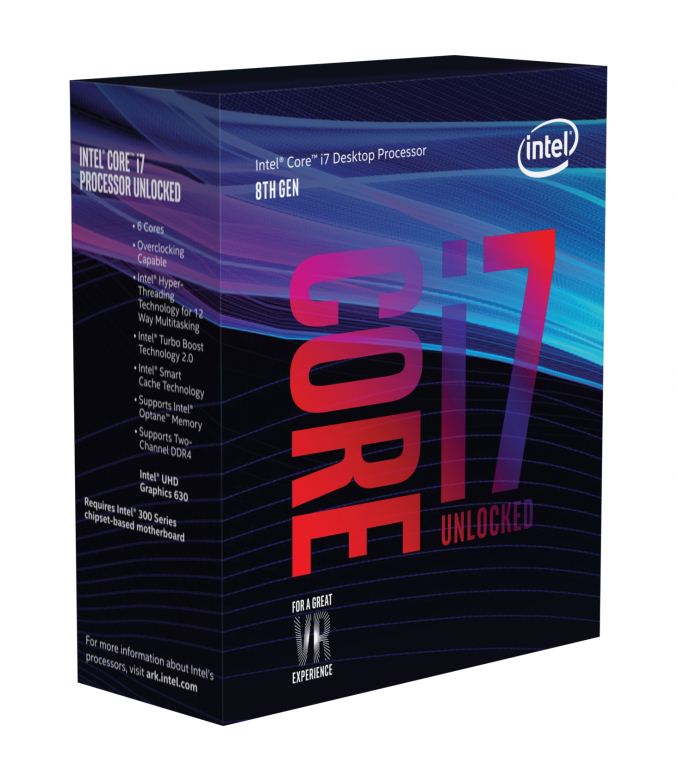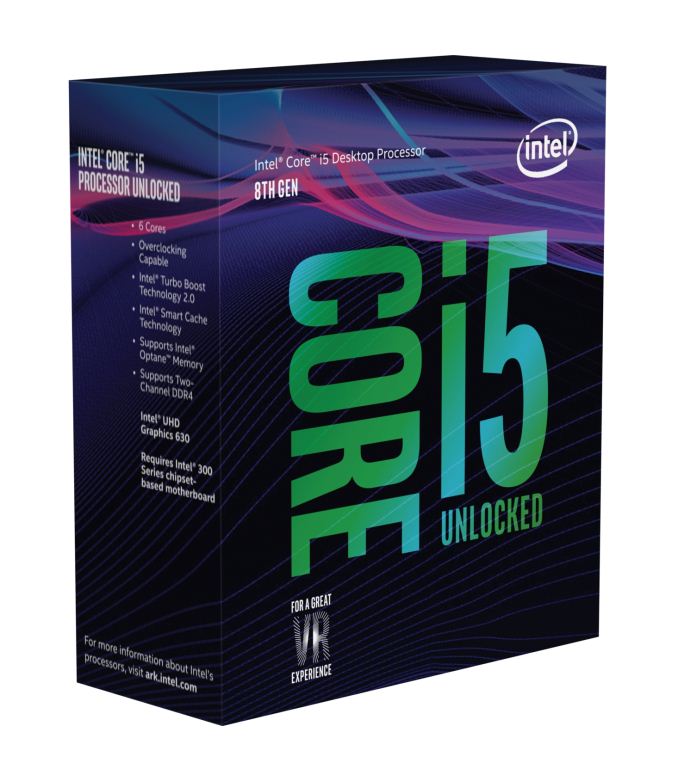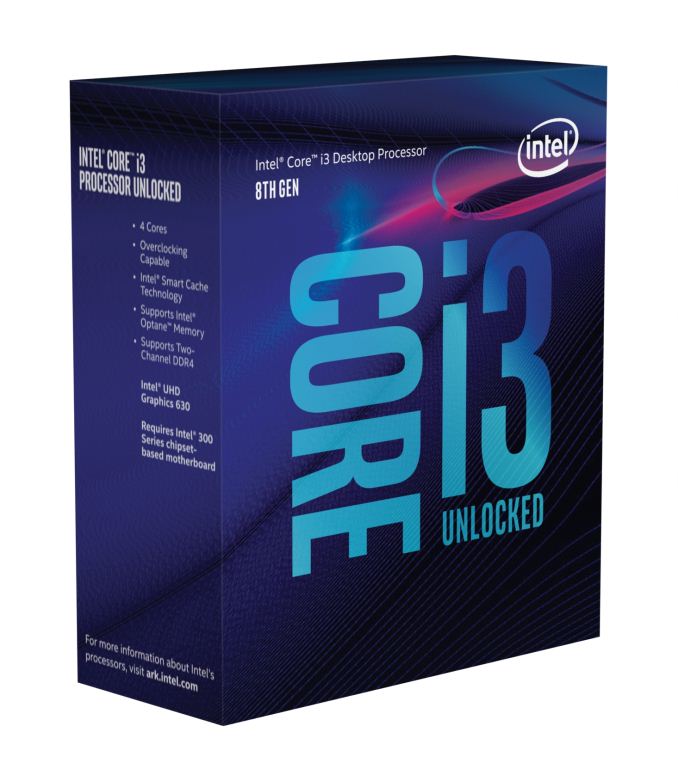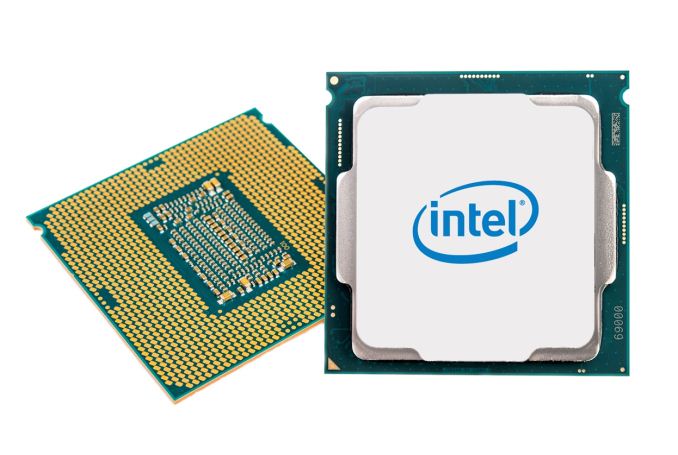The AnandTech Coffee Lake Review: Initial Numbers on the Core i7-8700K and Core i5-8400
by Ian Cutress on October 5, 2017 9:00 AM EST- Posted in
- CPUs
- Intel
- Core i5
- Core i7
- Core i3
- 14nm
- Coffee Lake
- 14++
- Hex-Core
- Hyperthreading
Intel Coffee Lake Conclusion
It has been a long time coming, but we finally have something bigger than a quad-core processor on Intel’s mainstream platform. Fundamentally it might be the same architecture as the processors preceded it, but after a decade of quad-core Intel parts, it comes as a welcome improvement. Intel sampled us the Core i7-8700K and the Core i5-8400 for this set of initial launch testing, with the goal of offering more high performance cores at more mainstream price points without having to invest in the company's more expensive and otherwise more complex HEDT platforms.
The Core i7-8700K
The Core i7-8700K in our testing was designed to be the new halo mainstream processor: many cores and the highest frequencies seen on an Intel part out of the box, with the option of overclocking thrown in. With a peak turbo frequency of 4.7 GHz, in benchmarks that could be stripped down to a single core with no other work going on, the i7-8700K took home the bacon.
The problem here is the same problem we’ve seen with big core parts and Windows 10, however: these large processors can only take so much before having to move threads around, to keep both the frequency high and the energy density low. All it takes is for a minor internal OS blip and single-threaded performance begins to diminish. Windows 10 famously kicks in a few unwanted instruction streams when you are not looking, and as a result the CPU fires up another CPU core and drops to a lower turbo bin. Consequently the average single thread performance seen on the 8700K might be equal or lower than that of the previous generation. It becomes an infuriating problem to debug as a reviewer.
Nonetheless, when software needs to take advantage of the cores, the Core i7-8700K will run through at an all-core turbo frequency of 4.3 GHz, consuming about 86W in the process. The jump up from a quad-core to a hex-core for only a $20 difference will be immediately noticeable in the software that can take advantage of it.
What is interesting to note is that the Core i7-8700K essentially kills the short-lived Kaby Lake-X parts on the X299 high-end desktop platform. Again, for a few extra dollars on the 8700K, a user can save over $100 on the motherboard, get more cores and more performance, and not have the hassle of dealing with a hybrid X299 platform. It does make me wonder why Intel released Kaby Lake-X in the first place, if they knew just how short lived they would be.
When comparing against the Core i7-7800X, a high-end desktop part at a similar price and with the same core count but a lower frequency, it really comes down to what the user needs. Performance easily favors the Core i7-8700K, however that cannot replace the quad-channel memory (up to 128GB) and the 28 PCIe lanes that the Core i7-7800X can support. In most circumstances, especially gaming, the Core i7-8700K will win out.
Intel’s 8th Generation CPUs: The Ones To Watch
Intel also sampled us the Core i5-8400, showing that six-core processors can cost less than $200. This processor, along with the Core i3-8100, will form the new backbone of general computing when using Intel components: the Core i3-8100 replaces old Core i5 processors for around $120, and enthusiasts who simply want a little more oomph can go with the Core i5-8400 at $190 at retail. It almost comes across as adding 50% cost for adding 50% performance. Personally I think the Core i3-8100, if made widely available, will be a top-selling processor for casual desktop users and gamers who were previously looking for a good performance-per-dollar part.
There is one other comparison to note: the Core i5-8600K and the Core i7-8700. These two parts are $50 apart, however the Core i7-8700 has double the threads, +10% raw frequency, 33% more L3 cache, and 1/3 lower TDP. The Core i5-8600K has overclocking, however going up to the i7 ensures stability, and should offer more raw performance. It will be interesting to get these two in to test, and especially to see if the TDP rating makes a significant performance difference.
Today’s Review Takeaway
We finally have six-core processors on Intel’s mainstream platform, which has driven up the core counts (and frequencies) of the company's low and mid-range processors. For anyone looking at building a system in the last 6-12 months, they should be able to build an equivalent with the latest-generation processor for $50-$100 less. Or spend the same and get a few more cores to play with. The last time we had this situation was a decade ago, and hopefully it won’t take another decade to happen again.
Dedicated reviews for the processors (with more gaming tests) are on the cards. Stay tuned!















222 Comments
View All Comments
boeush - Friday, October 6, 2017 - link
To expand on this a bit more, with the "core wars" now in effect, I wonder if hyperthreading might be an unnecessary holdover feature that could be actually reducing performance of many(8+)-core chips in all but the most extremely threaded scenarios. Might it not be better to have many simple/efficient cores, rather than perhaps fewer cores loaded with the hyperthreading overhead both in terms of die area and energy density, as well as cache thrashing?Zingam - Saturday, October 7, 2017 - link
Hyperthreading was invented to optimize the use of CPU logic that would otherwise remain unutilized during high loads.There is no way of reducing performance with current architectures. There are "hyperthreading-less" CPUs and you compare them to hyperthreded CPUs.boeush - Monday, October 9, 2017 - link
Hyperthreading was particularly useful in the context of not having a lot of cores to work with - allowing to squeeze extra multi-threaded performance from your dual- or quad-core CPU. It comes at the cost of extra silicon and complexity in the CPU pipeline, but allows better utilization of CPU resources as you mention. At runtime, it has the dual detrimental effects on single-thread performance, of (1) splitting/sharing the on-CPU cache among more threads, thereby raising the frequency of cache misses for any given thread due to the threads trampling over each other's cached data, and (2) indeed maximizing CPU resource utilization, thereby maximizing dissipated energy per unit area - and thereby driving the CPU into a performance-throttling regime.With more cores starting to become available per CPU in this age of "core wars", it's no longer as important to squeeze every last ounce of resource utilization from each core. Most workloads/applications are not very parallelizable in practice, so you end up hitting the limits of Amdahl's law - at which point single-thread performance becomes the main bottleneck. And to maximize single-thread performance on any given core, you need two things: (a) maximum attainable clock frequency (resource utilization be damned), and (b) as much uncontested, dedicated on-CPU cache as you can get. Hyperthreading is an impediment to both of those goals.
So, it seems to me that if we're going toward the future where we routinely have CPUs with 8 or more cores, then it would be beneficial for each of those cores to be simpler, more compact, more streamlined and optimized for single-thread performance (while foregoing hyperthreading support), while spending any resulting die space savings on more cores and/or more cache.
boeush - Monday, October 9, 2017 - link
To add to the above: 'more cores and/or more cache' - and/or better branch predictor, and/or faster/wider ALU and/or FPU, and/or more pipeline stages to support a faster clock, and/or...alinypd - Saturday, October 7, 2017 - link
Slowest GAMING CPU Ever, Garbage!yhselp - Saturday, October 7, 2017 - link
The i3-8100 is made utterly redundant by the the necessity to buy a Z370 motherboard along with it; it'd be cheaper to get an i5-7400 with a lower-end motherboard. Intel...watzupken - Saturday, October 7, 2017 - link
This applies to all the non-overclocking chips, particularly i5 and below. The high cost of the Z370 boards currently simply wipe out any price benefits. For example, a i5 840 is good value for money, but once you factor in the price of a motherboard with a Z370 chipset, it may not be that good value for money anymore.FourEyedGeek - Saturday, October 7, 2017 - link
Enjoyed the article, thanks. An overclocked Ryzen 1700 looks appealing.nierd - Saturday, October 7, 2017 - link
"The problem here is *snip* Windows 10, *snip* All it takes is for a minor internal OS blip and single-threaded performance begins to diminish. Windows 10 famously kicks in a few unwanted instruction streams when you are not looking,"This is why single threaded performance is a silly benchmark in today's market, unless you happen to boot to DOS to run something. Your OS is designed to use threads. There are no systems in use today as a desktop (in any market these processors will compete - even if used as a server) where they will ever run a single thread. The only processors that run single threads today are ... single core processors (without hyperthreading even).
Open your task manager - click the performance tab - look at the number of threads - when you have enough cores to match that number then single threaded performance is important. In the real world how the processor handles multiple tasks and thread switching is more important. Even hardcore gamers seem to miss this mark forgetting that behind the game the OS has threads for memory management, disk management, kernel routines, checking every piece of hardware in your system, antivirus, anti-malware (perhaps), network stack management, etc. That's not even counting if you run more than one monitor and happen to have web browsing or videos playing on another screen - and anything in the background you are running.
The myth that you never need more than 4 cores is finally coming to rest - lets start seeing benchmarks that stress a system with 10 programs going in the background. My system frequently will be playing a movie, playing a game, and running handbrake in the background while it also serves as a plex server, runs antivirus, has 32 tabs open in 2 different browsers, and frequently has something else playing at the same time - A true benchmark would be multiple programs all tying up as many resources as possible - while a single app can give a datapoint I want to see how these new multi-core beasts handle real world scenarios and response times.
coolhardware - Sunday, October 8, 2017 - link
Your comment has merit. It is crazy the number of tasks running on a modern OS. I sometimes miss the olden days where a clean system truly was clean and had minimal tasks upon bootup. ;-)